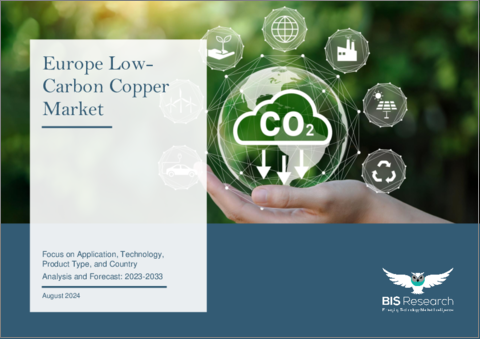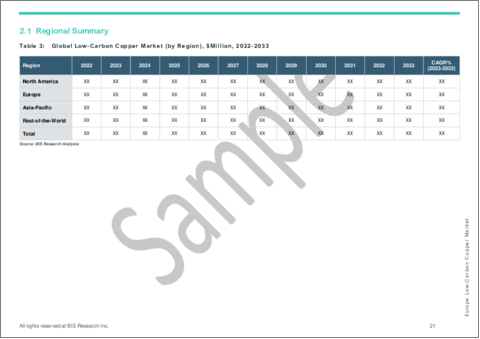|
|
市場調査レポート
商品コード
1540778
欧州の低炭素銅市場:用途別、技術別、製品タイプ別、国別 - 分析と予測(2023年~2033年)Europe Low-Carbon Copper Market: Focus on Application, Technology, Product Type, and Country - Analysis and Forecast, 2023-2033 |
||||||
カスタマイズ可能
|
|||||||
| 欧州の低炭素銅市場:用途別、技術別、製品タイプ別、国別 - 分析と予測(2023年~2033年) |
|
出版日: 2024年08月27日
発行: BIS Research
ページ情報: 英文 65 Pages
納期: 1~5営業日
|
全表示
- 概要
- 図表
- 目次
欧州の低炭素銅の市場規模は、2023年の189億1,000万米ドルから2033年には383億4,000万米ドルに達し、予測期間の2023年~2033年のCAGRは7.32%になると予測されています。
低炭素銅の採用は、世界中の政府による厳しい環境規制によって後押しされると予想されます。低炭素銅市場が拡大しているのは、こういった規制のおかげでもあり、より持続可能でクリーンな採掘・抽出方法を支持しているからです。特に先進国では、環境にやさしい製造工程に投資する企業に対し、各国政府がインセンティブを与えています。生産性、経済性、持続可能性、拡張性を向上させる製造業の技術開発は、おそらくこの分野でも浸透していくと思われます。持続可能性の目標を採用し、環境要因を企業戦略に組み込む企業が増えています。カーボン・フットプリントを減らし、持続可能なサプライ・チェーンを奨励することで、低炭素銅の需要が高まると予測されます。
| 主な市場統計 | |
|---|---|
| 予測期間 | 2023年~2033年 |
| 2023年の評価 | 189億1,000万米ドル |
| 2033年の予測 | 383億4,000万米ドル |
| CAGR | 7.32% |
欧州の低炭素銅市場は、持続可能性と二酸化炭素排出量削減を重視する産業界や政府の高まりの結果、拡大しています。低炭素銅は、再生可能エネルギー、自動車、エレクトロニクス、建築など、さまざまな業界で人気が高まっています。従来の方法で生産された銅に比べ、温室効果ガスの排出が大幅に少ないのです。EUのグリーン・ディールや、2050年までにカーボン・ニュートラルを達成するというその他の気候変動目標に対応した、環境にやさしい素材への需要が高まっていることが、このシフトを後押ししているのです。
電気自動車(EV)の普及、太陽光発電や風力発電のような再生可能エネルギー、エネルギー効率の高いインフラ、これらすべてが市場の拡大に貢献し、銅の投入を大きく求めています。こうした産業とともに、持続可能な素材への要求も高まり、生産者はリサイクル銅を使ったり、再生可能エネルギーで動く施設から調達するなど、低炭素銅の生産方法を革新せざるをえなくなります。
加えて、CSRや持続可能なサプライチェーンに対する意識の高まりから、企業は環境目標を達成するために低炭素銅を選択しています。欧州の低炭素銅市場は、規制の圧力と環境にやさしい製品を求める消費者の声の高まりから、今後数年で著しい成長が見込まれます。これは大陸全体の脱炭素化への取り組みに貢献するとみられています。
当レポートでは、欧州の低炭素銅市場について調査し、市場の概要とともに、用途別、技術別、製品タイプ別、国別の動向、および市場に参入する企業のプロファイルなどを提供しています。
目次
エグゼクティブサマリー
第1章 市場
- 動向:現在および将来の影響評価
- サプライチェーンの概要
- 規制状況
- ステークホルダー分析
- 市場力学の概要
第2章 地域
- 地域別概要
- 欧州
- 地域概要
- 市場成長促進要因
- 市場成長抑制要因
- ドイツ
- フランス
- ロシア
- イタリア
- その他
第3章 市場-競合ベンチマーキングと企業プロファイル
- 地理的評価
- ELCOWIRE GROUP AB
- Boliden Group
- ABB
- Antofagasta plc.
- Dahren Group
- Glencore
第4章 調査手法
List of Figures
- Figure 1: Europe Low-Carbon Copper Market (by End-Use Application), 2022, 2026, and 2033
- Figure 2: Europe Low-Carbon Copper Market (by Technology), 2022, 2026, and 2033
- Figure 3: Europe Low-Carbon Copper Market (by Product Type), 2022, 2026, and 2033
- Figure 4: low-carbon copper, Recent Developments
- Figure 5: Supply Chain and Risks within the Supply Chain
- Figure 6: Impact Analysis of Market Navigating Factors, 2023-2033
- Figure 7: Germany Low-Carbon Copper Market, $Million, 2022-2033
- Figure 8: France Low-Carbon Copper Market, $Million, 2022-2033
- Figure 9: Russia Low-Carbon Copper Market, $Million, 2022-2033
- Figure 10: Italy Low-Carbon Copper Market, $Million, 2022-2033
- Figure 11: Rest-of-Europe Low-Carbon Copper Market, $Million, 2022-2033
- Figure 12: Strategic Initiatives, 2021-2023
- Figure 13: Share of Strategic Initiatives, 2021-2023
- Figure 14: Data Triangulation
- Figure 15: Top-Down and Bottom-Up Approach
- Figure 16: Assumptions and Limitations
List of Tables
- Table 1: Market Snapshot
- Table 2: Low-Carbon Copper Market, Opportunities/Risks
- Table 3: Global Low-Carbon Copper Market (by Region), $Million, 2022-2033
- Table 4: Europe Low-Carbon Copper Market (by Application), $Million, 2022-2033
- Table 5: Europe Low-Carbon Copper Market (by Technology), $Million, 2022-2033
- Table 6: Europe Low-Carbon Copper Market (by Product Type), $Million, 2022-2033
- Table 7: Germany Low-Carbon Copper Market (by Application), $Million, 2022-2033
- Table 8: Germany Low-Carbon Copper Market (by Technology), $Million, 2022-2033
- Table 9: Germany Low-Carbon Copper Market (by Product Type), $Million, 2022-2033
- Table 10: France Low-Carbon Copper Market (by Application), $Million, 2022-2033
- Table 11: France Low-Carbon Copper Market (by Technology), $Million, 2022-2033
- Table 12: France Low-Carbon Copper Market (by Product Type), $Million, 2022-2033
- Table 13: Russia Low-Carbon Copper Market (by Application), $Million, 2022-2033
- Table 14: Russia Low-Carbon Copper Market (by Technology), $Million, 2022-2033
- Table 15: Russia Low-Carbon Copper Market (by Product Type), $Million, 2022-2033
- Table 16: Italy Low-Carbon Copper Market (by Application), $Million, 2022-2033
- Table 17: Italy Low-Carbon Copper Market (by Technology), $Million, 2022-2033
- Table 18: Italy Low-Carbon Copper Market (by Product Type), $Million, 2022-2033
- Table 19: Rest-of-Europe Low-Carbon Copper Market (by Application), $Million, 2022-2033
- Table 20: Rest-of-Europe Low-Carbon Copper Market (by Technology), $Million, 2022-2033
- Table 21: Rest-of-Europe Low-Carbon Copper Market (by Product Type), $Million, 2022-2033
- Table 22: Market Share
Introduction to Europe Low-Carbon Copper Market
The Europe low-carbon copper market is projected to reach $38.34 billion by 2033 from $18.91 billion in 2023, growing at a CAGR of 7.32% during the forecast period 2023-2033. Low-carbon copper adoption is expected to be boosted by strict environmental regulations put in place by governments across the globe. The low-carbon copper market is expanding in part because of these regulations, which support more sustainable and clean mining and extraction methods. Governments are providing incentives to businesses that invest in environmentally friendly manufacturing processes, especially in developed nations. Technological developments in manufacturing that enhance productivity, economy, sustainability, and expandability are probably going to catch on in the sector. A growing number of businesses are adopting sustainability goals and integrating environmental factors into their corporate strategies. It is projected that the dedication to lowering carbon footprints and encouraging sustainable supply chains will increase demand for low-carbon copper.
| KEY MARKET STATISTICS | |
|---|---|
| Forecast Period | 2023 - 2033 |
| 2023 Evaluation | $18.91 Billion |
| 2033 Forecast | $38.34 Billion |
| CAGR | 7.32% |
Market Introduction
The European market for low-carbon copper is expanding as a result of growing industry and government emphasis on sustainability and cutting carbon emissions. Low-carbon copper is becoming more and more popular in a number of industries, including renewable energy, automotive, electronics, and construction. It is produced with substantially fewer greenhouse gas emissions than copper produced using traditional methods. The growing demand for eco-friendly materials that support the Green Deal of the European Union and other climate targets aimed at reaching carbon neutrality by 2050 is what is driving this shift.
The increasing use of electric vehicles (EVs), renewable energy sources like solar and wind power, and energy-efficient infrastructure all contribute to the market's expansion and call for significant copper inputs. The demand for sustainable materials rises along with these industries, forcing producers to innovate in low-carbon copper production methods, such as using recycled copper or sourcing from renewable energy-powered facilities.
In addition, businesses are selecting low-carbon copper to fulfill their environmental objectives due to growing awareness of CSR and sustainable supply chains. The Europe low-carbon copper market is expected to grow significantly in the coming years due to regulatory pressures and growing consumer demand for environmentally friendly products. This will help with the continent's overall decarbonization efforts.
Market Segmentation
Segmentation 1: by End-Use Application
- Power Generation and Distribution
- Building and Construction
- Consumer Electronics
- Automotive
- Others
Segmentation 2: by Technology
- Pyrometallurgy
- Hydrometallurgy
Segmentation 3: by Product Type
- Recycled Low-Carbon Copper
- Virgin Low-Carbon Copper
Segmentation 4: by Country
- Germany
- France
- Russia
- Italy
- Rest-of-Europe
How can this report add value to an organization?
Product/Innovation Strategy: This report provides a comprehensive product/innovation strategy for the Europe low carbon copper market, identifying opportunities for market entry, technology adoption, and sustainable growth. It offers actionable insights, helping organizations leverage low carbon copper to meet environmental standards, gain a competitive edge, and capitalize on the increasing demand for eco-friendly solutions in various industries.
Growth/Marketing Strategy: This report offers a comprehensive growth and marketing strategy designed specifically for the Europe low carbon copper market. It presents a targeted approach to identifying specialized market segments, establishing a competitive advantage, and implementing creative marketing initiatives aimed at optimizing market share and financial performance. By harnessing these strategic recommendations, organizations can elevate their market presence, seize emerging prospects, and efficiently propel revenue expansion.
Competitive Strategy: This report crafts a strong competitive strategy tailored to the Europe low carbon copper market. It evaluates market rivals, suggests methods to stand out, and offers guidance for maintaining a competitive edge. By adhering to these strategic directives, companies can position themselves effectively in the face of market competition, ensuring sustained prosperity and profitability.
Key Market Players and Competition Synopsis
The companies that are profiled in the report have been selected based on inputs gathered from primary experts and analyzing company coverage, product portfolio, and market penetration.
Some of the prominent names in this market are:
- ELCOWIRE GROUP AB
- Boliden Group
- ABB
- Antofagasta plc.
- Dahren Group
- Glencore
Table of Contents
Executive Summary
Scope and Definition
1 Markets
- 1.1 Trends: Current and Future Impact Assessment
- 1.1.1 Trends: Current and Future Impact Assessment
- 1.1.2 Trend 1: Increased Demand from Key Industries
- 1.1.3 Trend 2: Rise of Electric Vehicles (EVs)
- 1.1.4 Trend 3: Sustainability and Recycling Efforts
- 1.2 Supply Chain Overview
- 1.2.1 Market Map
- 1.3 Regulatory Landscape
- 1.3.1 Consortiums and Associations
- 1.3.2 Regulatory Bodies
- 1.3.3 Government Programs
- 1.3.4 Programs by Research Institutions and Universities
- 1.4 Stakeholder Analysis
- 1.5 Market Dynamics Overview
- 1.5.1 Market Drivers
- 1.5.1.1 Consumer Demand for Sustainable Products
- 1.5.1.2 Automotive Industry's Adoption of Low-Carbon Copper for Electric Vehicles and Beyond
- 1.5.1.3 Environmental Regulations and Policies
- 1.5.2 Market Restraints
- 1.5.2.1 High Cost of Production
- 1.5.2.2 Supply Chain Challenges
- 1.5.3 Market Opportunities
- 1.5.3.1 Sustainability and Recycling Practices
- 1.5.3.2 Integration of Industry 4.0 Technologies
- 1.5.1 Market Drivers
2 Regions
- 2.1 Regional Summary
- 2.2 Europe
- 2.2.1 Regional Overview
- 2.2.2 Driving Factors for Market Growth
- 2.2.3 Factors Challenging the Market
- 2.2.3.1 Application
- 2.2.3.2 Product
- 2.2.4 Germany
- 2.2.4.1 Application
- 2.2.4.2 Product
- 2.2.5 France
- 2.2.5.1 Application
- 2.2.5.2 Product
- 2.2.6 Russia
- 2.2.6.1 Application
- 2.2.6.2 Product
- 2.2.7 Italy
- 2.2.7.1 Application
- 2.2.7.2 Product
- 2.2.8 Rest-of-Europe
- 2.2.8.1 Application
- 2.2.8.2 Product
3 Markets - Competitive Benchmarking & Company Profiles
- 3.1 Geographic Assessment
- 3.1.1 ELCOWIRE GROUP AB
- 3.1.1.1 Overview
- 3.1.1.2 Top Products/Product Portfolio
- 3.1.1.3 Top Competitors
- 3.1.1.4 Target Customers
- 3.1.1.5 Key Personnel
- 3.1.1.6 Analyst View
- 3.1.1.7 Market Share, 2022
- 3.1.2 Boliden Group
- 3.1.2.1 Overview
- 3.1.2.2 Top Products/Product Portfolio
- 3.1.2.3 Top Competitors
- 3.1.2.4 Target Customers
- 3.1.2.5 Key Personnel
- 3.1.2.6 Analyst View
- 3.1.2.7 Market Share, 2022
- 3.1.3 ABB
- 3.1.3.1 Overview
- 3.1.3.2 Top Products/Product Portfolio
- 3.1.3.3 Top Competitors
- 3.1.3.4 Target Customers
- 3.1.3.5 Key Personnel
- 3.1.3.6 Analyst View
- 3.1.3.7 Market Share, 2022
- 3.1.4 Antofagasta plc.
- 3.1.4.1 Overview
- 3.1.4.2 Top Products/Product Portfolio
- 3.1.4.3 Top Competitors
- 3.1.4.4 Target Customers
- 3.1.4.5 Key Personnel
- 3.1.4.6 Analyst View
- 3.1.4.7 Market Share, 2022
- 3.1.5 Dahren Group
- 3.1.5.1 Overview
- 3.1.5.2 Top Products/Product Portfolio
- 3.1.5.3 Top Competitors
- 3.1.5.4 Target Customers
- 3.1.5.5 Key Personnel
- 3.1.5.6 Analyst View
- 3.1.5.7 Market Share, 2022
- 3.1.6 Glencore
- 3.1.6.1 Overview
- 3.1.6.2 Top Products/Product Portfolio
- 3.1.6.3 Top Competitors
- 3.1.6.4 Target Customers
- 3.1.6.5 Key Personnel
- 3.1.6.6 Analyst View
- 3.1.6.7 Market Share, 2022
- 3.1.1 ELCOWIRE GROUP AB
4 Research Methodology
- 4.1 Data Sources
- 4.1.1 Primary Data Sources
- 4.1.2 Secondary Data Sources
- 4.1.3 Data Triangulation
- 4.2 Market Estimation and Forecast





